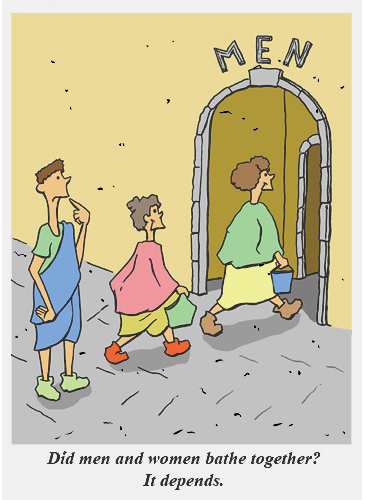|
|
|
Return to CooperToons Soundbytes of History |
The Roman Baths - Creating Equality Around the Empire
A Most Merry and Illustrated Soundbyte of History
Everyone knows about the Roman baths. Those were the humongous elaborate spas that were open to everyone in the Roman empire. Regardless of the indivdual's status or wealth, the bath became virtually a daily routine for the inhabitants of the Roman world. It was at the baths that paupers rubbed elbows with emperors, plebians with patricians, and even the occasional slave with the freedman.
But one question seems to fascinate the modern public which seems titillated (no pun intended) by the idea of Roman public bathing. Did the men and women bathe together?

This subject has been studied in detail by modern scholars, particularly Garrett Fagan of the Pennsylvania State University. His answer is straightforward and unequivocal. It depends. Sometimes they did and sometimes they didn't.
Same or mixed gender bathing was largely a matter of local custom, personal inclinations, and the practice of the particular establishment. There are certainly enough references from the Romans themselves that we know that at least in some places the two genders mixed most freely. Apparent contradictions in the evidence are not really contradictions. It just means there was no uniformity in the custom from place to place and time to time.
Roman husbands and wives in general had separate social lives. So in the early times the bathing was most likely men with men and women with women, and some inscriptions support this theory. As times went on and women began to mix socially with men, and as there was no specific law against mixed bathing, it made sense that the ladies would begin to join the fellows at the local balneum. For instance if there was a dinner party, the guests and hosts would often first meet at the baths. As some parties included husbands and wives, logistics would be simplified if the couples both went to take a dip together.
Still the practice seems to have been considered a bit daring and in some places the genders were kept separate. The huge sprawling imperial bath complexes had no separate sections for men and women, and from time to time some of the more prissy emperors would issue the occasional proclamation against men and women rubbing elbows (and other parts) in the local tepidarium, caldarium, and frigidarium. To handle the emperors' wishes, there would have to be separate times allocated for men and women. This is much like the Middle Eastern hammams operating today, and which are direct descendants of the Roman bathing establishments.
On the other hand some bath houses, like the Stabian baths at Pompeii, had clearly marked separate facilities. But there were still common areas where both sexes could mingle and socialize. There was a large open air swimming pool, the natatio, for everyone's use. Part of the bathing procedure was to work up a bit of a sweat, and so there was an exercise courtyard where you would play ball, roll a hoop, smack a wooden sword against a wooden target - that sort of stuff. We know these areas were available to the ladies, and we even have mosaics depicting bikini clad ladies working out. And of course if a guy or gal wanted to sit down and relax with a gal or a guy there was always the ....
Well, perhaps that information is best reserved for  . But certainly the readers are of sufficient breadth of tolerance that they will sure feel no discomfiture if they simply click here.
. But certainly the readers are of sufficient breadth of tolerance that they will sure feel no discomfiture if they simply click here.
References
Bathing in Public in the Roman World, Garrett Fagan, University of Michigan Press (1999). The most modern study of Roman bathing. Professor Fagan points out that the contradictions in the epigrammatical, archeological, and literary evidence is best explained by realizing that there were no uniform rules for any given time or place. Still, descriptions by the poet Martial (Gaius Valerius Martialis) leave no doubt that the baths were places where the ladies and gentlemen could meet on terms of (wink, wink) equality. Of course Martial was living in racy, steamy Rome, but it's unlikely the provincial brethren and sisters were all that different from their cosmopolitan counterparts.
Return to CooperToons Soundbytes of History